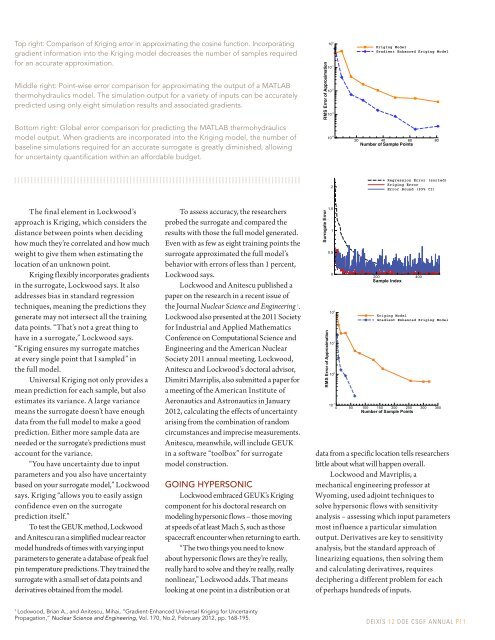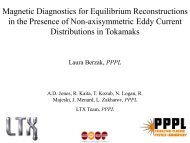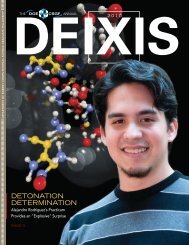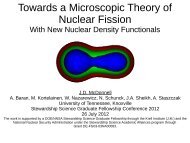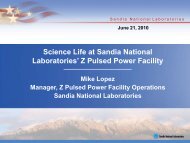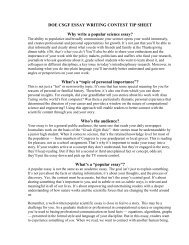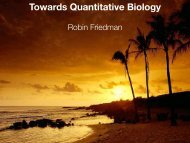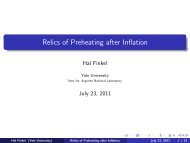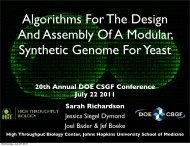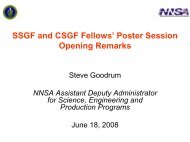2012 - Krell Institute
2012 - Krell Institute
2012 - Krell Institute
You also want an ePaper? Increase the reach of your titles
YUMPU automatically turns print PDFs into web optimized ePapers that Google loves.
Top right: Comparison of Kriging error in approximating the cosine function. Incorporating<br />
gradient information into the Kriging model decreases the number of samples required<br />
for an accurate approximation.<br />
Middle right: Point-wise error comparison for approximating the output of a MATLAB<br />
thermohydraulics model. The simulation output for a variety of inputs can be accurately<br />
predicted using only eight simulation results and associated gradients.<br />
Bottom right: Global error comparison for predicting the MATLAB thermohydraulics<br />
model output. When gradients are incorporated into the Kriging model, the number of<br />
baseline simulations required for an accurate surrogate is greatly diminished, allowing<br />
for uncertainty quantification within an affordable budget.<br />
RMS Error of Approximation<br />
10 0 Kriging Model<br />
Gradient Enhanced Kriging Model<br />
10 -1<br />
10 -2<br />
10 -3<br />
10 -4<br />
20 40 60 80<br />
Number of Sample Points<br />
2<br />
Regression Error (sorted)<br />
Kriging Error<br />
Error Bound (99% CI)<br />
The final element in Lockwood’s<br />
approach is Kriging, which considers the<br />
distance between points when deciding<br />
how much they’re correlated and how much<br />
weight to give them when estimating the<br />
location of an unknown point.<br />
Kriging flexibly incorporates gradients<br />
in the surrogate, Lockwood says. It also<br />
addresses bias in standard regression<br />
techniques, meaning the predictions they<br />
generate may not intersect all the training<br />
data points. “That’s not a great thing to<br />
have in a surrogate,” Lockwood says.<br />
“Kriging ensures my surrogate matches<br />
at every single point that I sampled” in<br />
the full model.<br />
Universal Kriging not only provides a<br />
mean prediction for each sample, but also<br />
estimates its variance. A large variance<br />
means the surrogate doesn’t have enough<br />
data from the full model to make a good<br />
prediction. Either more sample data are<br />
needed or the surrogate’s predictions must<br />
account for the variance.<br />
“You have uncertainty due to input<br />
parameters and you also have uncertainty<br />
based on your surrogate model,” Lockwood<br />
says. Kriging “allows you to easily assign<br />
confidence even on the surrogate<br />
prediction itself.”<br />
To test the GEUK method, Lockwood<br />
and Anitescu ran a simplified nuclear reactor<br />
model hundreds of times with varying input<br />
parameters to generate a database of peak fuel<br />
pin temperature predictions. They trained the<br />
surrogate with a small set of data points and<br />
derivatives obtained from the model.<br />
To assess accuracy, the researchers<br />
probed the surrogate and compared the<br />
results with those the full model generated.<br />
Even with as few as eight training points the<br />
surrogate approximated the full model’s<br />
behavior with errors of less than 1 percent,<br />
Lockwood says.<br />
Lockwood and Anitescu published a<br />
paper on the research in a recent issue of<br />
the Journal Nuclear Science and Engineering 1 .<br />
Lockwood also presented at the 2011 Society<br />
for Industrial and Applied Mathematics<br />
Conference on Computational Science and<br />
Engineering and the American Nuclear<br />
Society 2011 annual meeting. Lockwood,<br />
Anitescu and Lockwood’s doctoral advisor,<br />
Dimitri Mavriplis, also submitted a paper for<br />
a meeting of the American <strong>Institute</strong> of<br />
Aeronautics and Astronautics in January<br />
<strong>2012</strong>, calculating the effects of uncertainty<br />
arising from the combination of random<br />
circumstances and imprecise measurements.<br />
Anitescu, meanwhile, will include GEUK<br />
in a software “toolbox” for surrogate<br />
model construction.<br />
GOING HYPERSONIC<br />
Lockwood embraced GEUK’s Kriging<br />
component for his doctoral research on<br />
modeling hypersonic flows – those moving<br />
at speeds of at least Mach 5, such as those<br />
spacecraft encounter when returning to earth.<br />
“The two things you need to know<br />
about hypersonic flows are they’re really,<br />
really hard to solve and they’re really, really<br />
nonlinear,” Lockwood adds. That means<br />
looking at one point in a distribution or at<br />
Surrogate Error<br />
RMS Error of Approximation<br />
1.5<br />
1<br />
0.5<br />
0<br />
10 1<br />
10 0<br />
200 400<br />
Sample Index<br />
10 2 Kriging Model<br />
Gradient Enhanced Kriging Model<br />
10 -1<br />
0 50 100 150 200 250 300 350<br />
Number of Sample Points<br />
data from a specific location tells researchers<br />
little about what will happen overall.<br />
Lockwood and Mavriplis, a<br />
mechanical engineering professor at<br />
Wyoming, used adjoint techniques to<br />
solve hypersonic flows with sensitivity<br />
analysis – assessing which input parameters<br />
most influence a particular simulation<br />
output. Derivatives are key to sensitivity<br />
analysis, but the standard approach of<br />
linearizing equations, then solving them<br />
and calculating derivatives, requires<br />
deciphering a different problem for each<br />
of perhaps hundreds of inputs.<br />
1<br />
Lockwood, Brian A., and Anitescu, Mihai, “Gradient-Enhanced Universal Kriging for Uncertainty<br />
Propagation,” Nuclear Science and Engineering, Vol. 170, No.2, February <strong>2012</strong>, pp. 168-195.<br />
DEIXIS 12 DOE CSGF ANNUAL P11


